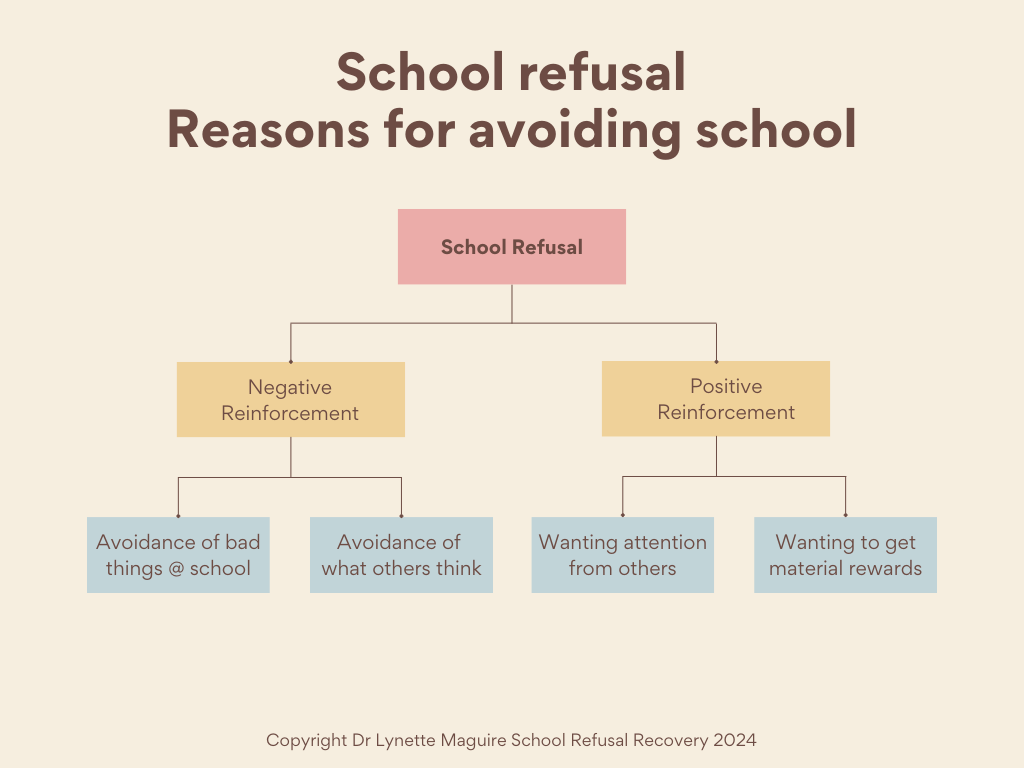Lesson 1 Homework, Tips and Case Studies

Once we figure out why your child is refusing school, it will be easier to work on a strategy for treatment. Let’s see if we can identify the reasons for school refusal in the following case studies.

Sarah is 11 and has started to refuse to go to school, complaining of pains in the belly every school morning. She cries and has started to act violently when her mother tries to force her to go. Sarah has revealed that some of the girls at school are mean to her. Sarah’s mother has to go to work, and when her mother gives in, she phones Sarah’s grandmother to see if she can come over and watch Sarah. When Nana arrives she fusses over Sarah, and let’s her play video games then takes her out for ice-cream. Using the four drivers of school refusal above, which one/s are impacting Sarah’s school refusal:
Right! Sarah has three reasons for avoiding school: the bullies, the attention and the video games and ice-cream.
Sarah has three reasons for avoiding school: the bullies, the attention and the video games and ice-cream.
Billy is 8 and has been refusing school for about 3 months. Recently he bumped into Fredrik who mentioned some cool science stuff they were working on in class. Billy didn’t really understand when Frederik explained what they were doing and since then Billy has doubled down with his refusal of school. Using the four drivers of school refusal above, which one/s are impacting Billy’s school refusal:
Yes, it sounds like Billy is worried the other kids at school will think he’s dumb because he doesn’t understand the Science experiment which is Avoidance of what others might think.
It sounds like Billy is worried the other kids at school will think he’s dumb because he doesn’t understand the Science experiment which is Avoidance of what others might think.
Nick is 15 and likes to game and often does this into the early hours of the morning. When it’s time for him wake to go to school he says he’s too tired so his father lets him sleep in and he misses school. When he wakes up he meets up with some friends, then comes home and starts gaming again. Using the four drivers of school refusal above, which one/s are impacting Nick’s school refusal:
Nick is allowed to miss school because of his gaming and spends his day hanging with friends (Tangible Rewards) Nick’s behavior also falls into the category of Behavioral-based school refusal (Truancy).
Nick is allowed to miss school because of his gaming and spends his day hanging with friends (Tangible Rewards) Nick’s behavior also falls into the category of Behavioral-based school refusal (Truancy).
Now it’s your turn. Write a paragraph like we have stating what happens when your child refuses school. Can you identify from the four reasons above, which ones play a part in your child’s school refusal?
When a parent understands the principles of Operant Conditioning, specifically positive and negative reinforcement and punishment, they can take real steps to address and reduce their child’s school refusal behavior.
Strategies to help you understand why your child is school refusing
If your child won’t or can’t tell you why they’re refusing school, here are some strategies to help you figure it out:
STEP 1: Break a typical school day down into chunks and have your child grade the level of distress they have out of 10 for each part (0/10 least fear – 10/10 most fear).
OR: If your child is very young, you can draw three faces like this: 🙂 😐 🙁 and have your child point to a face for each section of their day.
Write it all down so your list might look like this:
1. Putting uniform on
2. Getting on the bus (or however your child gets to school);
3. Walking into school grounds
4. Home class
5. Science class
6. Recess
7. Art class
8. English class
9. Lunch
10. Math class
11. Sport class
12. Trip home
With your child, run through each of the sections of their day and have them grade each out of 10 – the ones with the highest numbers are likely triggers for the school refusal. HINT: Keep this list for some work we’ll do on developing an Exposure Plan in Lesson 3.
If your child does not cooperate, do this instead
The following forms have been designed for School Refusal – there is one for the child to complete and one for the parent to complete. You’ll notice when you look at the questions that each refers to the four reasons for school refusal (Avoiding, Escape, Attention Seeking, Tangible Rewards). Add up your scores – basically the highest scores are the reason for the school refusal.
HINT: Your child may not want to do this exercise, that’s okay, you can do the adult based form to get some idea of what’s going on for your child.
Now you have a better idea of why your child is refusing school, let’s move onto some helpful parenting tips which will help your home become more harmonious. Try these out this week and let us know how you go in the School Refusal Recovery Facebook group.
School Refusal Assessment Forms to Download
It is likely that for some of you, your child does not want to talk about school or why they do not want to attend. Luckily, these forms have been developed to help you out, there’s one for you and one for your child. If your child is young, you might have to ask them the questions and complete the form. If your child does not want to participate, that’s fine, you can fill out the form for parents. Add up all the columns and those with the higher numbers relate to each driver of the school refusal: Avoidance, Escape, Attention, or Rewards.
Week 1: Parenting tips
Enforce home rules for school refusers (Negative Punishment)
I cannot stress how important this tip is – it is paramount to the success of getting your child back to the classroom.
Basically, only allow your child to do something that they would be allowed to do at school (eg. no use of phones, music, tv, etc).
- Set an alarm the same time as if the child was going to school
- Remove the child’s devices
- Do not allow tangible rewards such as going out for lunch or allowing gaming
- Do not make a fuss of the child – go about your day
- Enforce learning plans – your child needs to keep up with their school work
- At the end of the ‘school day’ allow your child normal privileges (these rules are enforced during normal school hours – including the time it takes to go to and from school)
- Turn off the modem and remove devices at the same time every night to ensure they get enough sleep.
- Do not allow any gaming at night. Ever.
Irrespective of the trigger, maintain a calm and logical demeanor. If there’s a conflict, it’s best to remove the emotion and use the “grey rock” approach (below) where their behavior is not triggering you and thus transitioning the argument. Stick to the point.
Be the ‘grey rock’
Parenting is hard and can be overly emotional. When your child is defiant, they may be angry, and this may make you angry. Emotional gut reactions generally don’t help to calm conflict, so it’s best to recognize what’s occurring and remove the instinct to be angry, but instead handle the situation in a calm voice. Often children provoke fights to deflect from the situation at hand – basically to change the discussion (another avoidance technique). Repeat in your head ‘be the grey rock’, to calm yourself and remove all emotion, and maintain a more logical approach. Make sure your breathing is calm – the goal is to not get emotional.
Link privileges to good behavior (positive reinforcement)
Privileges should be taken away if your child is disrespectful to you or others, refuses to comply with house rules, or calls you or anyone else names. These are behaviors that must not be reinforced. Privileges are electronics, internet, gaming, money, driving, sleepovers, and time with friends and these should only be allowed when the child is behaving appropriately. Don’t worry about thinking you’ll be mean, you’re actually doing your kid a favor doing this (more about this later). Reinforce ‘good’ behaviors only and always punish ‘bad’ behaviors.
Great job for getting through Lesson 1. See you next Lesson.
